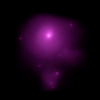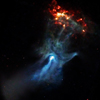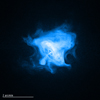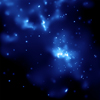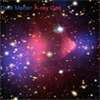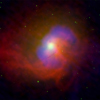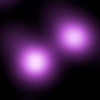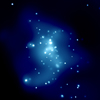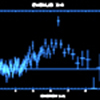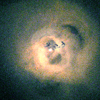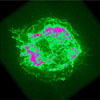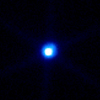Disclaimer: This material is being kept online for historical purposes. Though accurate at the time of publication, it is no longer being updated. The page may contain broken links or outdated information, and parts may not function in current web browsers. Visit chandra.si.edu for current information.
Cool Stories From The Hot Universe
by Wallace TuckerJuly 23, 2009 ::
While in the process of pulling together a list of the top ten Chandra science stories, colleague P.Edmonds suggested that we also put together a list of Chandra's coolest news stories.
Rules of Cool:
- Cool can only be observed by those who are themselves cool.
- Cool cannot be manufactured, only observed.
- Cool cannot be accurately observed at all, because the act of discovering cool causes cool to take flight.
Not being an especially cool person - at least I don't think I'm cool, and I don't remember anyone ever saying I'm cool, and as I understand cool, if you're cool, you know it - I was perplexed. This confirms one of Malcolm Gladwell's rules of cool: ". . . it can be only be observed by those who are themselves cool."
"Do you mean most popular?" I asked.
"Well," he hesitated, making me wonder if he wasn't also cool-challenged, "Yes."
The discussion then devolved into a debate about how to measure popularity: web stats - tricky because of the inflation of hits on the Chandra site over the years, coverage by the media - not a cool bunch by and large - or maybe just what we at the Chandra Education and Public Outreach (EPO) think is cool - a comment that made me think that P.Edmonds might be cool after all.
Then there is the incomparable and usually incomprehensible Marshall McLuhan's famous observation that "...Hot media are... low in participation, and cool media are high in participation or completion by the audience."
If this is true, then X-ray astronomy, (along with gamma-ray astronomy), is the coolest branch of astronomy, even though cosmic X-rays are produced in the hottest places in the universe! Because an X-ray photon is thousands of times more energetic than an optical or infrared photon, there are generally many fewer photons represented in a typical Chandra image as compared to Hubble or Spitzer Telescope images. So, some participation by the observer is needed to complete the interpretation (which is why we are grateful to have such good illustrators and animators on our EPO staff.)
"Secrets are the very root of cool." William Gibson
"The most beautiful thing we can experience is the mysterious." Albert Einstein
Add this to the fact that you can't go outside at night and "see" an X-ray star because they are invisible, and you begin to grasp the "coolness" of X-ray astronomy. It makes you think. In fact, this must be why all astronomical images are pretty cool. They make you wonder.
With the "wonder-full" criterion in mind, the Chandra EPO group put together the following list of cool Chandra stories, realizing that if too many people agree that they're cool, they may cease to be cool - see Gladwell's rules of cool. The list is not in any order of priority because we suspect that would be uncool.
"The meaning of cool is beyond definition. And as I said, beyond modification.
It just is, man." Stephen King, best-selling author of horror novels and self-proclaimed authority on cool.
This story requires lots of effort on the part of the reader to know what we're getting at, but few if any things are more mysterious than the evidence that most of the energy in the universe is in some form that no one understands.
PSR B1509-58: A Young Pulsar Shows its Hand
The "hand of God" stuff about this image probably got out of hand, but the image definitely makes you wonder, especially when you realize that a neutron star only twelve miles in diameter is responsible for this beautiful X-ray nebula that spans 150 light years.
Crab Nebula:Fingers, Loops and Bays in The Crab Nebula
What's really cool about this image are those circles in the center, and the jet, which are thought to be produced by electrons and antimatter electrons created near the surface of the neutron star in the center, and racing away from the star at near the speed of light. This antimatter is real, not just Angels and Demons fantasy.
The Galactic Center: Light Echo from the Milky Way's Black Hole, and, Milky Way's Giant Black Hole Awoke from Slumber
These stories are cool because they illustrate how not looking at an object can sometimes provide valuable information about the object. In this case, the object not looked at is Sagittarius A*, the supermassive black hole at the center of the Galaxy. Astronomers observed an increase in X-ray activity from two sets of gas clouds 50 and 300 light years away from Sgr A*, and deduced that these were light echoes produced by outbursts from the black hole 50 and 300 years ago. The one from 300 years ago indicates that Sgr A* was a million times more active than it is today.
The Bullet Cluster: NASA Finds Direct Proof of Dark Matter
A high speed collision between thousands of galaxies, multimillion degree gas clouds more massive than all the stars in the galaxies, and even more massive clouds of dark matter. The best proof yet that most of the matter in the universe is in some mysterious form that astronomers call "cold dark matter," so this discovery is beyond cool.
NGC 4696: Black Holes Found to Be Green by NASA's Chandra
Black holes are the ultimate alternative energy source. This research on supermassive black holes in the centers of galaxies shows that the process of converting gravitational energy of matter falling toward black holes into light and jets of high-energy particles is much more efficient than nuclear energy or fossil fuels. It has been estimated that if a car was as fuel-efficient as some black holes, it could travel more than a billion miles per gallon!
SN 2006gy: NASA's Chandra Sees Brightest Supernova Ever
This cool story hinged on just four X-rays detected by Chandra. In fact, it would have been far less cool if Chandra had detected thousands of X-rays, because that would have suggested that the supernova was caused by a white dwarf exploding in a dense environment. As it turned out, the evidence points toward a long-predicted but never observed type of supernova that occurs only in extremely massive that are greater than 150 times the mass of the Sun. Sometimes the absence of evidence can be the most important evidence of all.
Westerlund 1: Neutron Star Discovered Where a Black Hole Was Expected
The Westerlund 1 star cluster, and its sibling, Westerlund 2, were more or less ignored for years because they are hidden in a dusty part of the Galaxy difficult to observe with optical telescopes. Infrared and X-ray telescopes have shown that they are very cool collections of very massive stars, and at least one puzzling neutron star that according to a simple interpretation of stellar theory, should have been a black hole. What happened?
Saturn: Saturn's Rings Sparkle with X-rays
Chandra images reveal that the rings of Saturn sparkle in X-rays (blue dots in this X-ray/optical composite). The likely source for this radiation is the fluorescence caused by solar X-rays striking oxygen atoms in the water molecules that comprise most of the icy rings. Nothing very profound, but there's something about this image that's cool.
Cygnus X-1: "Iron-Clad" Evidence for Spinning Black Hole
No cool images here, just X-ray spectra, which reveal what's going on just a few dozen miles from a black hole, much closer than the distance of Boston from New York City. Not that we're implying that New York City is a black hole!
Other cool stories:
Perseus A Sound WavesA supermassive black hole is producing sound waves that correspond to B flat, 57 octaves below middle-C! As a reader wrote, "Imagine playing Bach's Passacaglia & Fugue in C on this celestial organ."
Cassiopeia A: Elemental Image Of Exploded Star
Not the most beautiful Cas A image, but there’s something cool about an image that shows enough calcium atoms to make several nonillion glasses of milk.
Brown Dwarf LP 944-20: The Mouse That Roared - Chandra Captures Flare From Brown Dwarf
It's always cool when a mouse roars.
RX J1856.5-3754 and 3C58: Cosmic X-rays May Reveal New Form of Matter
This result has not been confirmed, but hey, it doesn't have to be right to be cool!
-Ten Years of Chandra
-Cool Stories From The Hot Universe
Disclaimer: This material is being kept online for historical purposes. Though accurate at the time of publication, it is no longer being updated. The page may contain broken links or outdated information, and parts may not function in current web browsers. Visit chandra.si.edu for current information.

